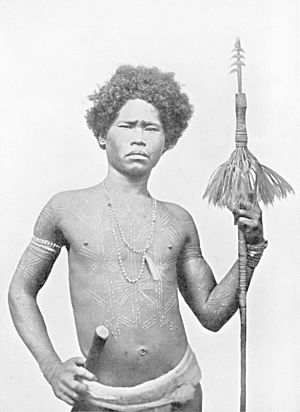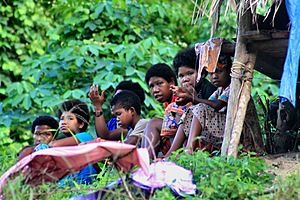Negrito facts for kids

A Luzon Negrito with spear
|
|
| Regions with significant populations | |
|---|---|
| Isolated geographic regions in India and Maritime Southeast Asia | |
| Languages | |
| Andamanese languages, Aslian languages, Philippine Negrito languages | |
| Religion | |
| Animism, folk religion, Christianity |
The term Negrito (/nɪˈɡriːtoʊ/) refers to several diverse ethnic groups who inhabit isolated parts of Southeast Asia and the Andaman Islands. Populations often described as Negrito include: the Andamanese peoples (including the Great Andamanese, the Onge, the Jarawa, and the Sentinelese) of the Andaman Islands, the Semang peoples (among them, the Batek people) of Peninsular Malaysia, the Maniq people of Southern Thailand, as well as the Aeta of Luzon Island, Ati, and Tumandok of Panay Island, Agta of Sierra Madre and Mamanwa of Mindanao Island and about 30 other officially recognized ethnic groups in the Philippines.
Etymology
The word Negrito is the Spanish diminutive of negro, used to mean "little black person." This usage was coined by 16th-century Spanish missionaries operating in the Philippines, and was borrowed by other European travellers and colonialists across Austronesia to label various peoples perceived as sharing relatively small physical stature and dark skin. Contemporary usage of an alternative Spanish epithet, Negrillos, also tended to bundle these peoples with the pygmy peoples of Central Africa on the basis of perceived similarities in stature and complexion. (Historically, the label Negrito has also been used to refer to African pygmies.) The appropriateness of bundling peoples of different ethnicities by similarities in stature and complexion has been challenged.
Culture
Most groups designated as "Negrito" lived as hunter-gatherers, while some also used agriculture, such as plant harvesting. Today most live assimilated to the majority population of their respective homeland. Discrimination and poverty are often problems, caused either by their lower social position, and or their hunter-gatherer lifestyles.
Origins
Based on perceived physical similarities, Negritos were once considered a single population of closely related people. However, genetic studies suggest that they consist of several separate groups descended from the same ancient East Eurasian meta-population which gave rise to modern East Asian peoples and Oceanian peoples, as well as displaying genetic heterogeneity. The Negritos form the indigenous population of Southeast Asia, but were largely absorbed by Austroasiatic- and Austronesian-speaking groups that migrated from southern East Asia into Mainland and Insular Southeast Asia with the Neolithic expansion. The remainders form minority groups in geographically isolated regions.
It has been found that the physical and morphological phenotypes of Negritos, such as short stature, a wide and snub nose, curly hair and dark skin, "are shaped by novel mechanisms for adaptation to tropical rainforests" through convergent evolution and positive selection, rather than a remnant of a shared common ancestor, as suggested previously by some researchers.
A Negrito-like population was mostly likely also present in Taiwan before the Neolithic expansion and must have had persisted into historical times, as suggested by evidence from morphological features of human skeletal remains dating from around 6,000 years ago resembling Negritos (especially Aetas in northern Luzon), and further corroborated by Chinese reports from the Qing period and from tales of Taiwanese indigenous peoples about people with "dark skin, short-and-small body stature, frizzy hair, and occupation in forested mountains or remote caves".
See also
 In Spanish: Negrito para niños
In Spanish: Negrito para niños



